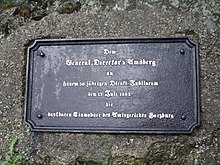Philipp August von Amsberg
Philipp August von Amsberg (born July 17, 1788 in Kavelstorf , † July 9, 1871 in Harzburg ) was a Brunswick statesman and founder of the first German state railway, the Duke of Brunswick State Railway .
Life
August Philipp Christian Theodor von Amsberg was the third child of pastor Johann David Theodor August von Amsberg (1747–1820). When he accidentally shot his older sister at the age of 12, he left his parents' parsonage to go to see his uncle in Salzdahlum in the Duchy of Braunschweig, who had since passed away. Thereupon he found accommodation with a merchant named Wollenweber in Braunschweig and learned the trade of merchant.
After attending the humanistic grammar school Martino-Katharineum in Braunschweig, von Amsberg worked in the directorate of direct taxes in the Oker department . From 1813 to 1815 he served in the corps of volunteer green hunters , rose to regimental paymaster with the rank of captain and was then taken back into the Brunswick state service as chamber secretary.
He was promoted to finance director (1835) through the offices of chamber assessor (1818), chamber councilor (1827), legation councilor (1829), secret legation councilor (1830) and secret superior delegation councilor (1832). In 1850 Amsberg became head of the ducal railway and post office in Braunschweig, which he headed until the state railway was sold in early 1871.
power
Amsberg mainly campaigned for trade facilitation in what was then a fragmented Germany. In 1830 he led the negotiations that led to the tax union between the states of Hanover , Kurhessen and Braunschweig. In the negotiations for the accession of the states of Oldenburg and Schaumburg-Lippe to the north German tax association , he was the Braunschweig representative, and on November 1, 1837, he concluded a contract with Prussia for the transportation of reciprocal traffic between Prussia and Braunschweig , which established the connection between Braunschweig and the 1834 German general customs union in 1842.
Amsberg recognized the importance of the railway for the economy as early as 1827. His project of a railway that was to connect Braunschweig, Hanover and Bremen with each other, however, failed due to resistance from King Ernst August of Hanover . However , he was able to overcome resistance to the construction of a national railway from Braunschweig to Harzburg . It was opened in December 1838 and established an economic boom for the duchy. When he died, he left behind a route network of 270 km in the Duchy of Braunschweig with connections to the neighboring railways.
Villa of Amsberg
In 1827 the ducal chief building director Peter Joseph Krahe built a villa for Amsberg at Friedrich-Wilhelm-Platz 3, opposite the later Braunschweig train station , which is oriented as a point de vue in the axis of the Bruchtorwall . The two-storey villa is part of the classicist overall planning of the promenade ring , which was built from 1800.
Between 1875 and 1931, as a result of the global economic crisis and the decline of the bank on Friedrich-Wilhelm-Platz , it was owned by the Meyersfeld family of banking . Until shortly before the Jewish family emigrated to South Africa under National Socialist rule , she ran a café. After the Second World War was in the villa the "Residenz-Café", from 1967 to the end of 1991 she was the seat of the private bank Marcard & Co. , and today it is one of the NORD / LB . In 2008, on the occasion of the architect's 250th birthday, the 500 square meter house was renovated and visually restored to its original state and then rented to a law firm.
Appreciations
- Amsbergstrasse in the Braunschweig district of Bebelhof , a former railway settlement , is named after Philipp August von Amsberg .
- In addition, the Amsbergstrasse in Bad Harzburg (near Goslarsche Strasse / Hindenburger Ring; below the Papenberg) was named after him.
literature
- Erhard Born (Hrsg.): Pioneers of the railway industry. Carl Röhrig Verlag, Darmstadt around 1961.
- Ludwig Ferdinand Spehr : August Philipp von Amsberg . In: Allgemeine Deutsche Biographie (ADB). Volume 1, Duncker & Humblot, Leipzig 1875, p. 411 f.
- Albert Trapp : Amsberg, August Philipp Christian Theodor von. In: New German Biography (NDB). Volume 1, Duncker & Humblot, Berlin 1953, ISBN 3-428-00182-6 , p. 260 ( digitized version ).
- Wilhelm M. Wunderlich: Amsberg, August Philipp Christian Theodor von. In: Horst-Rüdiger Jarck , Günter Scheel (ed.): Braunschweigisches Biographisches Lexikon - 19th and 20th centuries . Hahnsche Buchhandlung, Hannover 1996, ISBN 3-7752-5838-8 , p. 27 .
Individual evidence
- ↑ Wolfgang Kimpflinger: monuments in Lower Saxony. Volume 1.1 .: City of Braunschweig. Part 1. (= Monument Topography Federal Republic of Germany . ) Hameln 1993, ISBN 3-87585-252-4 , pp. 234-235.
- ↑ Simon Paulus, Ulrich Knufinke: The Braunschweiger Wallring. Guide to the history and architecture of a cultural and historical monument. Appelhans, Braunschweig 2011, ISBN 978-3-941737-59-4 .
- ↑ Reinhard Bein : You lived in Braunschweig. Biographical notes on the Jews buried in Braunschweig (1797 to 1983). (= Messages from the Braunschweig City Archives , No. 1). Döring Druck, Braunschweig 2009, ISBN 978-3-925268-30-4 , p. 519.
- ↑ Harald Duin: Villa von Amsberg - Pink becomes yellow. Braunschweiger Zeitung, July 2, 2008, p. 20.
See also
| personal data | |
|---|---|
| SURNAME | Amsberg, Philipp August von |
| BRIEF DESCRIPTION | German railroad director |
| DATE OF BIRTH | July 17, 1788 |
| PLACE OF BIRTH | Kavelstorf near Rostock |
| DATE OF DEATH | July 9, 1871 |
| Place of death | Bad Harzburg |

